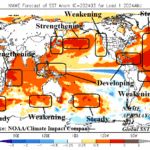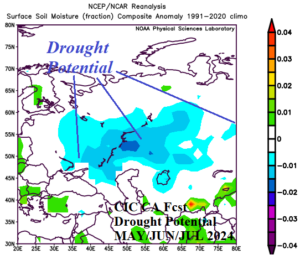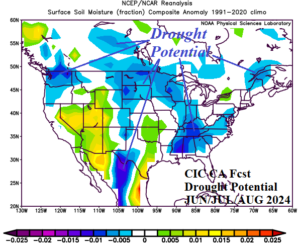Finding Climate Change in Northern Hemisphere Wintertime Upper Air Pattern During El Nino
03/05/2024, 2:53 pm EST
The March 2024 Global Marine Heat Wave Discussion and Outlook
03/20/2024, 3:58 pm EDT

Fig. 1-2: Based on a constructed analog, the projected 500 MB anomaly forecast and attendant soil moisture anomalies for MAY/JUN/JUL 2024 across Russia.


Fig. 3-4: Based on a constructed analog, the projected 500 MB anomaly forecast and attendant soil moisture anomalies for MAY/JUN/JUL 2024 across the U.S.
Discussion: Based on a constructed analog which identifies: 1.) The evolution of a warming mid-latitude ocean during the past 10 years, 2.) An enhanced warming of the mid-latitude oceans during the past 5 years, and 3.) Decelerating El Nino to La Nina climate, a projection of 500 MB anomalies and attendant soil moisture conditions for Western Russia and the U.S. is provided (Fig. 1-4). The purpose of this exercise is to identify areas of highest drought risk evolving during MAY/JUN/JUL in Western Russia and JUN/JUL/AUG across the U.S. and Southern Canada.
Results yield anomalous high pressure generating late spring into mid-summer near Caspian Sea which causes anomalous heat and dryness to inspire a large area of dry soils and possible drought extending from Southwest Russia across the Russia spring wheat crop zone. The dry soil condition extends well to the east throughout much of Russia.
In the U.S., the drought risk potential becomes evident during JUN/JUL/AUG with high pressure cresting over the Northwest U.S. and a relatively dry climate on the back side of an upper-level low-pressure area centered on Long Island. The attendant drought risk areas are the North-central U.S. including the Eastern Canadian Prairies plus parts of the Midwest States to the Tennessee Valley. Given this upper air pattern, the constructed analog yields a wet Southwest U.S. Monsoon and a wet regime in East Texas possibly related to an inland traveling tropical cyclone.
Summary: The projections indicated are based solely on the influence of the warming mid-latitude oceans which also includes presence of the North Atlantic warm hole (NAWH) east of New England. The warming oceans in the mid-latitudes are caused by stronger and longer lasting marine heatwaves certain to regenerate and intensify during the northern hemisphere warm season. Additionally, the anticipated transition from an El Nino to La Nina climate is included in this projection. Results yield drought potential for Western Russia and parts of Southern Canada, the Northern U.S., and Tennessee Valley and vicinity.
